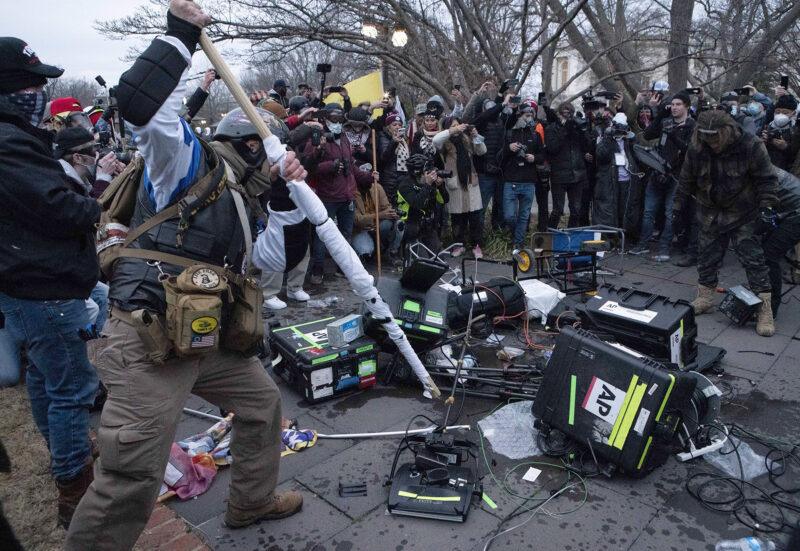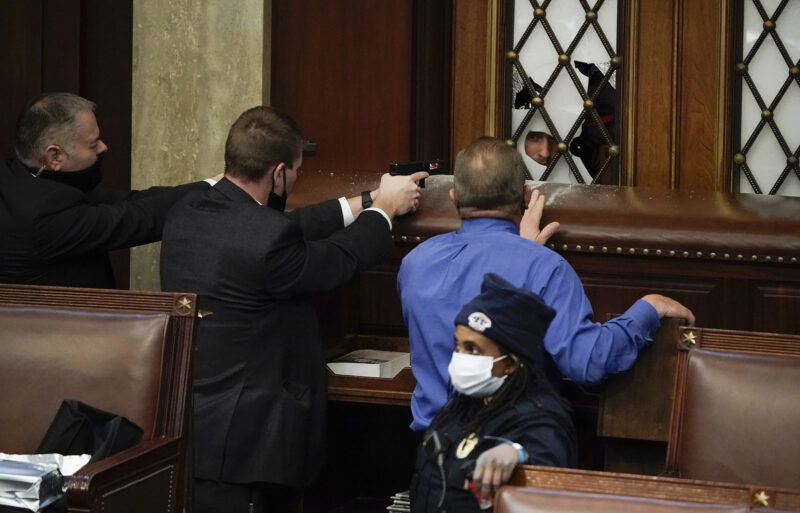AP staffers at the U.S. Capitol, themselves at risk, deliver searing images and a nonstop stream of breaking news during the mob assault on the halls of Congress.
The AP team arriving on Capitol Hill on Jan. 6 expected to cover history: an unprecedented challenge from Republicans lawmakers to the outcome of the presidential election. Within hours, however, those staffers found themselves covering an insurrectionist mob storming the U.S. Capitol.

President Donald Trump arrives to speak at a rally near the White House, Jan. 6, 2021.
AP Photo / Jacquelyn Martin
Journalists initially embedded in the protests forming on the streets, particularly a rally by President Donald Trump near the White House. Reporters Ashraf Khalil and Ben Fox were with the crowd as it first began to assemble, providing the first early color and quotes that revealed the intensity of those who would go on to attack the Capitol.
As Vice President Mike Pence opened the congressional session, the Trump supporters began streaming down Pennsylvania Avenue. A WhatsApp group linking the AP journalists — editors, photographers, video journalists — pinged incessantly as the crowd surged toward Capitol Hill.
Inside the building, reporters Mary Clare Jalonick and Andrew Taylor began hearing rumblings from sources that the situation was getting tense. Outside, video journalists Dan Huff, Nathan Ellgren and Hilary Powell, and photographers John Minchillo, Julio Cortez, Jose Magana, Carolyn Kaster and Jacquelyn Martin began beaming back images of U.S. Capitol Police being overrun.
At one critical point, a group of men grabbed Minchillo and surrounded him, accusing him of being an antifa infiltrator, hitting him from behind and throwing him over a retaining wall. Cortez, who was paired with him for safety, plunged in, recording all the while with the GoPro clipped to his helmet. The two eventually extracted themselves and moved away to transmit photos. The GoPro video shot by Cortez went viral globally on Facebook and Twitter, with more than 31,000 hits on AP’s YouTube channel.

Protesters smash AP broadcast equipment after the crew was forced to flee the mob outside the U.S. Capitol, Jan. 6, 2021.
AP Photo /Jose Luis Magana
Colleagues at AP Global Media Services, AP’s business supporting other broadcasters, faced danger too. Confronted outside the Capitol by a group of rioters, the GMS personnel attempted to calm the crowd but were eventually forced to leave for their own safety. The gear left behind was smashed. Producer Nan Hee McMinn and freelance cameramen Jaime Vera and Juan Quiroga acted coolly and professionally throughout.
Just a few minutes later, at 2:12 p.m., AP filed this alert:

It was one of more than 40 alerts Washington desk editors would send during a 24-hour period, reflecting the extraordinary churn of news.
Inside the Capitol, photographers Scott Applewhite and Andrew Harnik captured scenes of lawmakers diving for cover and donning gas masks, and law enforcement holding protesters at gunpoint as they tried to break into the House chamber. At the same time, Manny Ceneta was making photos of protesters roaming the hallways and confronting police outside the Senate.

Police hold their guns on protesters trying to break into the House chamber at the U.S. Capitol, Jan. 6, 2021.
AP Photo / J. Scott Applewhite
When officers ordered journalists to evacuate, Applewhite, who has covered the Capitol for decades, refused to leave. “I just told them I was fine and refused to leave. This is the AP — we stay and report,” Applewhite said. At various points along the way, with the cell network strained, the editors knew the photographers were safe only when photos started streaming directly from their cameras into the AP bureau.
Hours after texting her mother that she was in “Probably the safest place in Washington right now,” Jalonick, along with Taylor, evacuated to secure locations with House and Senate members, calling in news alerts and color and interviewing lawmakers for the mainbar. In addition to their first-person text stories, Jalonick also filed a first-person video and video of the evacuation recorded with her phone.
Reporters from every AP beat across Washington — White House, Congress, national security, law enforcement and domestic policy agencies — jumped in to help, urgently calling sources to get a handle on the security situation, taking feeds from colleagues in the field and tracking user-generated content.
Hours later, when the mob was finally contained, there was the business of Congress still to do. The Capitol Hill and White House teams worked into Thursday morning to cover Congress’ overnight affirmation of Joe Biden’s victory and President Donald Trump’s acknowledgement that he would leave power. It was well after 3 a.m. when those news alerts were filed.
“This is the AP — we stay and report.”
— AP photographer Scott Applewhite
By the time the sun was up, the whole bureau was awake — and breaking news again. Law enforcement reporters Colleen Long and Mike Balsamo and Pentagon reporter Lolita Baldor broke the news that Capitol Police had turned down offers of help with the siege, setting the agenda for days of reporting that would follow.
For their riveting real-time coverage as U.S. history unfolded, the courageous and dedicated staff on Capitol Hill earns AP’s Best of the Week award.

Rep. Andy Kim, D-N.J., cleans up debris and discarded items from the floor of the Rotunda of the U.S. Capitol in the early morning hours of Jan. 7, 2021, after protesters stormed the Capitol the previous day.
AP Photo / Andrew Harnik
Visit AP.org to request a trial subscription to AP's video, photo and text services.
For breaking news, visit apnews.com



























